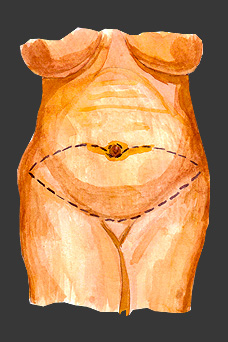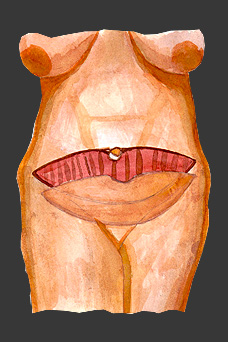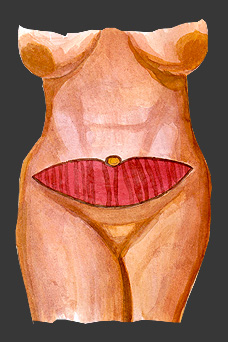Procedure
Abdominoplasty begins with a transverse incision in the lower part of the anterior abdominal wall, just above the pubic hairline. A second incision is then made directly above the umbilicus. The umbilicus itself is liberated from the surrounding tissue, in order to be repositioned towards the end of the procedure. The upper and lower incisions are then joined together so that the elliptical skin and excess fat flap is excised. Later, the rectus abdominis muscles are drawn together using special stitches and the area where the skin and subcutaneous tissues has been excised from the abdominal wall is covered with tissue from above the umbilicus.
In some cases it is possible to conduct a mini-abdominoplasty, when there is little excess tissue to be removed and the skin elasticity is good enough. In such cases the upper incision is made below the umbilicus, meaning that much less tissue needs to be removed.
| Abdominoplasty (tummy tuck) | ||||
 |
 |
|||
| Incision | Dissected tissue | |||
 |
 |
|||
| After removal of tissue | Postoperative scar | |||
Operation risks
Abdominoplasty, like any other intervention, can have side effects, such as reaction to anaesthesia, postoperative pain, swelling, tightness, and tissue fluid or blood accumulation at the surgical wound site. More rarely patients might experience prolonged bleeding, wound dehiscence, wound infection, and scar hypertrophy. Other possible complications or adverse reactions should be discussed with the plastic surgeon during the consultation.
Postoperative period
Usually patients return to work after 2-4 weeks. Physical activity restrictions should be followed for 1-3 months.
The cosmetic effect of an abdominoplasty can last for years or decades, but this is greatly dependent on the patient's lifestyle, diet and physical activity.
| Tautrimas Aštrauskas - Certified Plastic & Reconstructive Surgeon www.blossomandjasmine.com |
 |
 |
 |
solution: inverse.lt |
